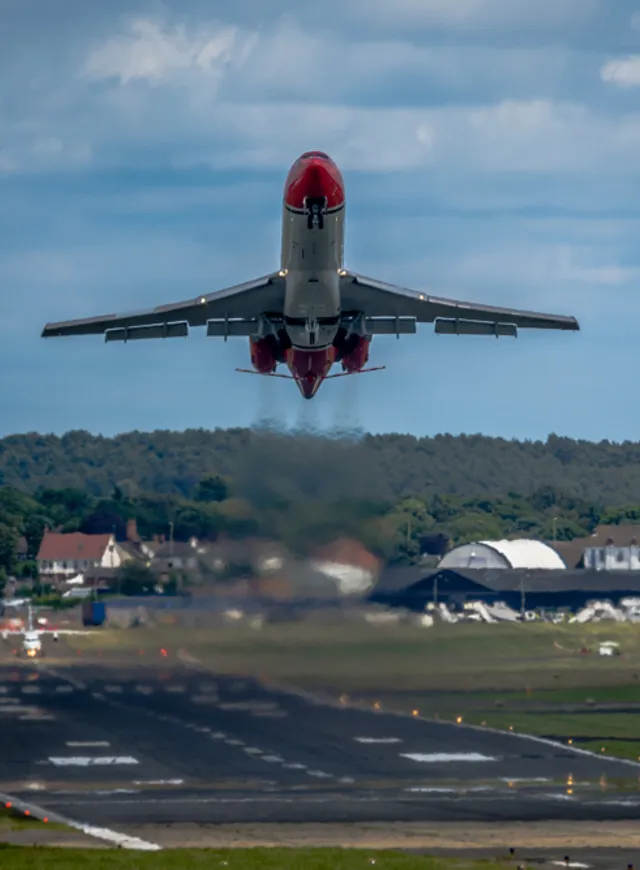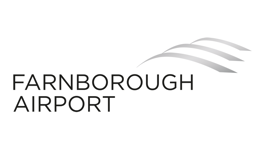
Enabling an airport’s net zero roadmap to take off
About Farnborough Airport
Farnborough Airport is the largest business aviation airport in the UK, handling more than 32,000 aircraft movements per year, and is consistently voted Europe’s number one premium airport. Serving London and the south of England, the airport serves corporate and business users alike as well as supporting visitors and residents of the UK for whom premium air travel connectivity makes London one of the world’s most attractive cities to reside in, visit and conduct business from.Farnborough Airport is the only dedicated and fully integrated airport of its kind, offering unparalleled levels of customer service and operational efficiency. Its state-of-the-art facilities and iconic architecture reflect significant investment in the airport over many years.
As well as being an important business aviation hub, Farnborough Airport is also host to the Farnborough International Airshow, a globally renowned trade and exhibition event for the aerospace and defence industries, where aircraft and associated technologies are demonstrated to potential investors from around the world.
A Global Showcase for Airport Sustainability
As a hard to abate sector, the aviation industry has some significant challenges to achieve Net Zero. The UK Government’s Jet Zero Strategy has set a target for aviation to be Net Zero by 2050, with airport operations Net Zero by 2040 and zero carbon routes being trialled by 2030.
Farnborough Airport has been at the forefront of sustainability over the years. In 2015 it achieved ISO 14001, then in 2018 it become the first business aviation airport in the world to achieve Carbon Neutrality. One of the airport’s stated aims is to be a global showcase for airport sustainability and it was a natural progression for it to want to set industry standards in achieving Net Zero across its Scope 1 & Scope 2 emissions over the coming years.
Net Zero Roadmap
Net Zero for Farnborough Airport will involve implementing a series of decarbonisation measures across both its infrastructure and operational activities. Identifying and quantifying these measures (both carbon and financial costs and benefits) was an important step in the process to developing its Net Zero Roadmap.
Determining the dependencies and enabling the measures needed, required a detailed understanding of the airport, its operations and the associated technologies. Further, these actions also required input from other stakeholders, such as the aircraft operators, passengers and airside operators. Identifying appropriate governance structures and knowledge sharing platforms were also an essential part of the project.
The Farnborough International Airshow is front and centre across the sector in showcasing new technologies that will help the sector become net zero. Held every two years, the Airshow puts Farnborough Airport in a unique position to support Net Zero across the broader aviation sector.
Why Ricardo
Farnborough Airport turned to Ricardo’s decarbonisation experts for our experience of supporting airports with their environmental and sustainability challenges. Ricardo understands what is required to generate suitable environmental impact mitigation measures. This included:
-
a detailed understanding of the strategic operations and environmental impact of airports
-
expertise on aircraft, airport and passenger vehicle technologies, combined with the adoption of sustainable technologies and robust management practices
-
modelling and forecasting expertise to evaluate scenarios and their impacts
-
monitoring capabilities to fully understand problems and track progress
-
capabilities to accurately model utility usage and waste management to optimise operations and control costs.
We have delivered net zero strategies for over 15 airports across the UK and are working on decarbonisation to support sustainable expansion plans for some of the largest airports operating out of London.
What we delivered for Farnborough Airport
Firstly, our experts worked with Farnborough Airport to better understand and review their current energy use and emissions.
We then provided a baseline carbon footprint, which was aligned with the global Airport Carbon Accreditation scheme’s requirements. For this, we worked closely with its sustainability team to agree the scope and boundary of the net zero roadmap, with the appropriate emissions sources included.
Next, we developed a heat decarbonisation strategy for the site, enabling a clear pathway for it to transition away from fossil fuels for heating. As part of this we identified decarbonisation measures that the airport has control of and those which it could influence.
The above were supplemented with site audits to give a detailed understanding of the age and performance of the current assets and to inform decisions around their replacement. We also had discussions to help gain an understanding of the carbon emissions trajectory, and arranged workshops to agree the measures to be implemented.
Identified measures
Capital projects that were in Farnborough Airport’s control included:
-
Alternative low carbon heating solutions for hangers
-
Alternative low carbon heating solutions for the airport
-
Enabling measures such as sub-metering, and upgrading the Building Management System (BMS)
-
Solar PV on-site and near-site
-
A fleet switching programme for alternative airside vehicles
Decarbonisation measures it can implement to influence change included:
-
Development of an internal net zero task force
-
Establishing three new forums:
-
for all organisations operating out of the airport, these focused on:
-
waste management and
-
energy management
-
-
for organisations operating airside a forum focused on transport
-
These decarbonisation measures were then developed into a net zero roadmap that it is now able to implement.
The outcome
Our work has enabled Farnborough Airport to demonstrate:
-
To the market: the pro-active approach they are taking to decarbonise
-
To customers: that Farnborough are working to make flight more sustainable
-
To contractors onsite: that they need to make change
We issued the final net zero roadmap report which included results of footprint calculations, breakdown by scope and emissions source, historical emissions comparisons, and a summary report, supplemented by the technical annex, which identified measures by which Farnborough Airport can significantly reduce GHG emissions and could be used to direct the next stages in its net zero journey.
Farnborough Airport then produced their own version of the roadmap (Roadmap to Net Zero by 2030 | Farnborough Airport).
They were impressed with the service from Ricardo, giving positive feedback and are open to further support in other areas of sustainability.
“Building upon Farnborough Airport’s successful track record of being at the forefront of sustainability matters, Ricardo’s strategic support and insight has helped us to continue that journey, having now established some of the most ambitious Net Zero targets within the aviation industry.” Simon Geere, Chief Executive Officer, Farnborough Airport
Find out more
Learn more about Farnborough’s journey to net zero: Farnborough Airport’s roadmap to net zero 2030
Related pages




